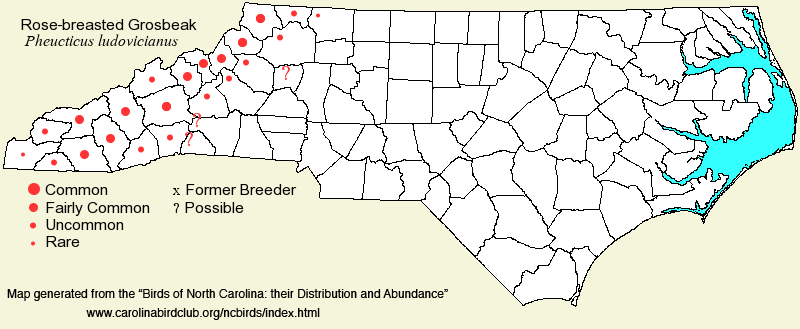 |  |
|
Rose-breasted Grosbeak - Pheucticus ludovicianus CARDINALIDAE Members: | Search Common: Search Scientific: |
|
|
|||||||
| General Comments | The Rose-breasted Grosbeak is a bird of the cooler hardwood and mixed forests of the eastern parts of the continent, ranging south through the Appalachians. Thus, it breeds in essentially all of the mountain counties in North Carolina, but otherwise it is found only in spring and fall in the Piedmont and Coastal Plain. The species seemed to have undergone a slight population decline, at least in the state's mountains, in the 1990's and early 2000's, but the population has rebounded somewhat. It is a classic bird of the "northern hardwood forest" -- breeding in mature stands of northern hardwoods, some cove forests, and other cool forests where a few conifers are mixed with the hardwoods. Birds are easily seen in early May when the hardwoods are still just leafing out. In migration downstate, grosbeaks are seen in a variety of hardwood forests and woodlots, usually in small groups, or mixed with other migrant species. They winter in the tropics, though as with most such songbirds, there are a few winter records for North Carolina, typically at feeders. | ||||||
| Breeding Status | Breeder | ||||||
| NC BRC List | Definitive | ||||||
| State Status | |||||||
| U.S. Status | |||||||
| State Rank | S3S4B | ||||||
| Global Rank | G5 | ||||||
| Coastal Plain | Transient. In spring, rare to uncommon along the western margin of the province, but generally rare over the region. In fall, uncommon over most of the region, being more likely to be seen along the immediate coast than farther inland. At least 14 winter records, all but two from coastal areas. Mainly late Apr to mid-May, and mid-Sep to mid-Oct. A female photographed at a feeder in New Bern (Craven) on 21 Jun 2018 was essentially a month late in departing. Peak counts: 6, on two dates. | ||||||
| Piedmont | Transient. In spring, uncommon to at times fairly common in the western portion, but uncommon over most of the province. In fall -- more numerous than in spring, being uncommon to fairly common over the region. Apparently eight winter records, if all were correctly identified; brown-plumaged Purple Finches have been called as female Rose-breasted Grosbeaks on a number of occasions (and vice-versa). A few summer records, often lingering at feeders into Jun. Mainly late Apr to mid-May, and mid-Sep to mid-Oct. Peak counts: | ||||||
| Mountains | Summer resident and transient. Fairly common (and common in a few ranges) in summer at middle to higher elevations, generally between 3,500 and 5,000 feet; uncommon down to about 3,000 feet and to 5,500 feet. Fairly common in spring migration, and common in fall, at most elevations; can be seen in large numbers for a day or two after cold fronts in fall. About six winter records, all in the southern half of the mountains (Buncombe, Madison, and Transylvania). Mainly mid- or late Apr to mid-Oct. Peak counts: 550, in flight over Balsam Gap in northeastern Buncombe, 21 Sep 2016; 400 at that gap, 24 Sep 2023; 200, Blue Ridge Junction along the Blue Ridge Parkway, 21 Sep 2003; 160+, Carvers Gap (Mitchell), 23 Sep 2013. | ||||||
| Finding Tips |
You should be able to find the species in a morning of birding along the Blue Ridge Parkway at elevations above 3,500 feet (but below the spruce-fir zone), from late Apr into jun, and then again in fall. *** to **** | ||||||
| Attribution | LeGrand[2025-05-09], LeGrand[2024-11-11], LeGrand[2024-05-15] | ||||||
| NC Map Map depicts all counties with a report (transient or resident) for the species. | Click on county for list of all known species. |
| NC Breeding Season Map Map depicts assumed breeding season abundance for the species. |  |